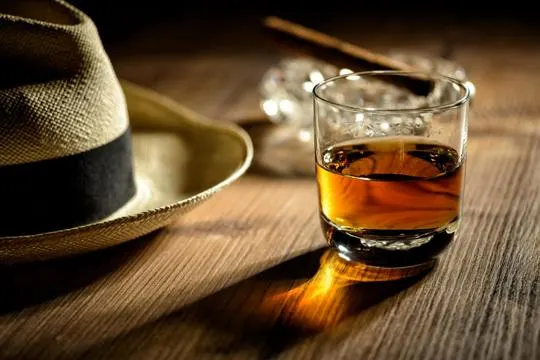Summary of key points
The main difference between light rum and dark rum is the aging process. Light rum is aged in steel tanks, while dark rum is aged in oak barrels for a longer period of time.
This distinction affects the taste and color of these two types of rum. Light rum tends to have a more subtle flavor with hints of vanilla or fruit, while dark rum has a stronger and richer taste with notes of caramel and spice. The color of dark rum is also darker due to the aging process.
In terms of uses, light rum is often used in cocktails or mixed drinks that require a lighter and more neutral taste, while dark rum is popular for sipping on its own or in drinks that call for a stronger flavor profile. Both types of rum can be interchangeable in some recipes, but the taste may be slightly different.
When it comes to health, both light rum and dark rum have similar calorie content. However, dark rum may offer more antioxidants due to its longer aging process. As with any alcohol, moderation is key for a balanced and healthy lifestyle.
Rum is not just a drink; it’s a story in a bottle. Each type reveals a tale of its own.
Light rum sparkles with a subtle sweetness, perfect for those breezy summer cocktails. On the flip side, dark rum brings a robust richness, its flavors deepened by age and often a whisper of spices.
We all have our go-to. I’m a dark rum devotee myself, thrilled by its complexity.
Yet, many swear by light rum’s versatility. It’s a debate as old as the Caribbean sun.
Making a pick isn’t merely about the drink; it’s choosing the vibe for the evening.
Light for laughter-filled nights under the stars, dark for introspective moments beside a crackling fire.
Your choice? It says a lot about you.
What is Light Rum?

Light rum, also known as white or silver, is a favorite for rum fans.
It’s a crystal clear spirit made from either sugarcane juice or molasses.
Aging it for shorter periods creates a light & mild flavor.
Versatility is a key feature of light rum.
Its subtle flavors blend perfectly into cocktails, letting the other ingredients stand out.
Light rum often stars in drinks like mojitos, daiquiris & piña coladas.
Plus, its cool & crisp taste refreshes these drinks.
It’s also an affordable choice.
Compared to dark rum, which has a complex flavor from aging longer, light rum is usually cheaper.
This makes it great for experimenting with cocktails without breaking the bank.
A unique taste comes with light rum too.
Depending on the brand or origin, you may pick up hints of vanilla, citrus or tropical fruit.
These add depth to drinks, yet keep the light & refreshing character.
What is Dark Rum?

A mysterious elixir, dark rum captivates the senses.
Crafted with care, this sophisticated spirit is a deep amber or mahogany hue.
It bursts with flavors of caramel, molasses, and spices.
Boldness and depth are its trademarks.
Ageing increases these flavors, making each sip like a melodic symphony.
With its robust character and intriguing profile, dark rum promises an indulgent experience.
For those seeking refined spirits, it beckons to be savored.
Differences Between Light Rum and Dark Rum

Light rum and dark rum have distinct flavors, aging processes, and uses.
Color and Appearance
When picking between light and dark rum, color and appearance can be a key distinguishing factor.
Light rum normally has a clear or pale yellow tone, whereas dark rum has an amber or brown color.
This is due to the maturation process and the type of barrels used.
Dark rum gets its deep color from being aged in charred oak barrels for a long time, giving it complex flavors and aromas.
Light rum, however, is usually aged for a short time or filtered after distillation, keeping its clear or light yellow hue.
Additives like caramel coloring can also influence the appearance of these rums.
Some producers use this to make their products look more attractive, even if they haven’t been aged for as long.
However, color isn’t necessarily connected to quality or taste.
It’s all down to personal preference and the desired flavor for cocktails and drinks.
So when looking at rums, observe their colors and let your taste buds lead you to the perfect one.
Distillation Process
Distillation is key when making rum.
It involves heating fermented molasses or sugarcane juice to create steam containing alcohol molecules.
The steam then rises and condenses, purifying the alcohol and removing impurities.
This ensures the final product keeps its flavor.
To understand the distillation process, it’s important to know the differences between light and dark rum.
Light rum has a shorter fermentation period and is distilled at lower temperatures.
This gives it a clear color and mild taste.
Dark rum is produced through a longer fermentation and higher distillation temperature.
This allows for more caramelization of sugars, giving it its deep color and robust flavor.
Other factors such as aging, blending, and additives also contribute to the final product’s characteristics.
Extra steps like aging in oak barrels or blending with different batches can be done to achieve certain flavor profiles.
Understanding the distillation process helps to appreciate the artistry behind rum.
Next time you enjoy your favorite rum cocktail or sip it neat, take a moment to recognize the craftsmanship that turns raw ingredients into liquid perfection.
Aging Period
When looking at rum’s aging, it’s clear that it affects the spirit’s taste and complexity.
Time in barrels gives rum unique flavors, scents, and traits.
Aging rum is a tough process that needs both patience and accuracy.
The longer rum ages, the more it interacts with wood barrels, absorbing flavors like vanilla, caramel, and spice.
This makes the final product deep and complex.
Different types of rum age for different lengths.
Light rums usually age less than dark rums.
This creates light, fresh flavors with tropical fruit hints.
Dark rums age longer, which gives them rich, strong flavors with molasses, chocolate, and oak hints.
Another factor that influences aging is climate.
In hot, humid climates, aging quickens.
Cooler climates slow down aging, allowing for a slower flavor development.
To get the taste you want, it’s essential to understand rum’s aging.
Whether you want crisp or bold flavors, how long the rum has aged helps you pick a variant you’ll enjoy.
Flavor Profile and Aromas
Rum, a spirit often linked to holidays in the tropics and beachside drinks, comes in many forms.
Light and dark rums each offer unique flavor profiles and aromas that can improve your drinking experience.
Light rum, also known as white or silver rum, is usually clear and has a gentle, delicate taste.
It tends to be less intense compared to its darker version.
Light rum works in fruity cocktails, such as mojitos or daiquiris, because its flavors blend with other ingredients without overpowering them.
Dark rum, on the other hand, has a richer, more robust flavor.
Aging it in oak barrels gives it a distinct caramelized taste with molasses, toffee, spice, and even hints of vanilla or chocolate.
Its complexity makes it an excellent choice to sip neat or on the rocks.
Light and dark rums also vary in production.
Light rum is usually distilled at higher proofs, making it a cleaner, neutral spirit.
Dark rum, however, ferments longer and is aged in charred barrels, which add extra flavors.
Light and dark rums can differ depending on the brand and country where it’s made.
The Caribbean region is renowned for its top-quality rums, due to its ideal climate for sugarcane cultivation.
When deciding between light and dark rum, consider your tastes and what you’re using it for.
If you like lighter, more refreshing drinks with subtle flavors, choose light rum.
If you prefer rich-tasting sips or adding depth to your cocktails, go for dark rum.
Similarities Between Light Rum and Dark Rum

Light and dark rum may look different, taste different, and be made differently.
However, they have some similarities too.
Both light and dark rum are made from sugar cane or molasses.
They both also have a sweetness that makes them different from other spirits.
Plus, you can use either one in your cocktails.
These similarities make them both great choices for rum lovers.
Cocktails Suited for Light Rum and Dark Rum
Light and dark rum can make all the difference when it comes to cocktails.
Light rum is great for drinks like mojitos and daiquiris with its subtle and crisp flavor.
It pairs well with other fruity mixers too.
Dark rum, however, brings a bolder flavor profile to drinks such as Mai Tais and Dark ‘n’ Stormy.
It has caramel notes and hints of vanilla.
Light rum, also known as white or silver, is usually aged briefly in oak barrels or not aged at all.
This preserves its flavor and allows for experimentation.
Dark rum is aged longer in charred oak casks.
This gives it woody tones and a smoother finish.
It’s perfect for sipping neat or on the rocks.
Conclusion
As always, when deciding which rum to choose it is up to the individual’s own personal taste; what may work one time may not be a winning combination the next time around.
Depending on your preference, light rum or dark rum could become go-to rums.
It often takes some experimentation and analysis to discover ones true love of rum.
Regardless of whether one chooses light or dark, or both, make sure to take the time to enjoy its complexity and appreciate its distinct flavors.
When choosing a particular rum we highly recommend trying out both varieties as there are some truly excellent releases worth exploring.
We wish you much success with tasting each kind and look forward to hearing your expert opinion on which match your taste buds best.

Leave a comment